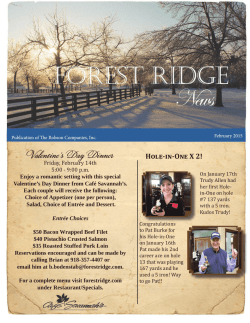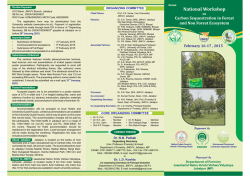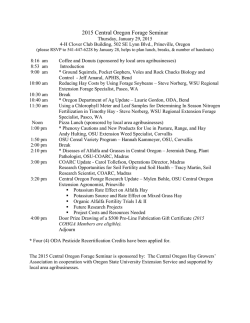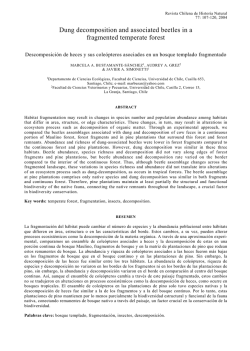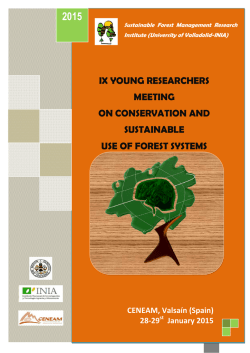
Download Newsletter - American Forest Resource Council
American Forest Resource Council 5100 S.W. Macadam Avenue, Suite 350 Portland, Oregon 97239 Phone: (503) 222-9505 Fax: (503) 222-3255 E-mail: [email protected] www.amforest.org January 30, 2015 SRS, Wildfire, O&C and Forestry Bills Secure Rural Schools As the 114th Congress gets underway several significant forestry issues that weren’t resolved in the last Congress are back on the agenda, and some key bills have already been re-introduced. One surprise was Congress’ failure to pass a one-year extension of the Secure Rural Schools (SRS) program late last year, particularly since Senator Ron Wyden (D-OR) made it one of his highest priorities as the chair of the powerful Senate Finance Committee. Wyden claimed that he had identified offsets to fund the reauthorization and later blamed House Republicans for its failure. The House disputed Wyden’s claims and questioned whether the offsets were viable. Without reauthorization of SRS, counties nationwide will return to actual receipt sharing formula this year, which will represent an 80% reduction in revenue or about a $240 million loss based on recent announcements by the Forest Service and BLM. Oregon will be hit particularly hard with Forest Service SRS payments plunging from $68 million to $6 million. Adding insult to injury was the recent announcement that sequestration would further reduce Forest Service payments by an additional 7 percent. Both Congressman Greg Walden (R-OR) and Senator Wyden have pledged to secure a oneyear extension during the first 90 days of Congress, but the path forward is unclear. Many counties are on the brink of financial calamity with the funding cuts and the failure to manage federal forests to generate jobs and revenue. Wildfire Borrowing Another symptom of the failure to manage our federal forests is the spiraling cost of fighting wildfires each year. Three bills were introduced in the last Congress to end the practice of “borrowing” for wildfire suppression activities, which often robs management accounts needed to fund forest management activities. Despite broad agreement that we must end the practice of fire borrowing, nothing passed the Congress. On January 22, Senators Mike Crapo (R-ID) and Ron Wyden reintroduced the Wildfire Disaster Funding Act (WDFA). Cosponsors of the bill include Senators James Risch (R-ID), Maria Cantwell (DWA), Ranking Member of the Senate Energy and Natural Resources Committee, Cory Gardner (R-CO), Michael Bennet (D-CO), Steve Daines (R-MT), and Tammy Baldwin (D-WI). Like the legislation from the last Congress, the bill creates a contingency fund for the estimated 1% of fires that consume 30% of firefighting budgets, and thus should be treated as natural disasters. Any fire suppression spending above 70% of the 10-year average for fire suppression would be funded under a separate disaster account and not from the Forest Service’s budget. Congressmen Mike Simpson (R-ID) and Kurt Schrader (D-OR) have also introduced a companion bill to the Wyden/Crapo bill in the House. 1 Finally, Senators John McCain (R-AZ), Jeff Flake (R-AZ), and John Barrasso (R-WY) have reintroduced their wildfire funding bill, which requires the Forest Service and Interior Department to budget for the total, improved 10-year average firefighting costs. Any suppression spending over that amount would be eligible for emergency disaster spending. In addition the bill also has a forest management title that would direct the Forest Service to treat 7.5 million acres mechanically during the next fifteen years to help reduce the wildfire risk. Additionally, in order to access the emergency suppression spending, $90 million would be required to be added to the Forest Service hazardous fuels program to further reduce fire risk. Wyden Reintroduces O&C Legislation On January 8, Senator Wyden reintroduced his O&C Lands Act claiming that it will “more than double timber harvest on Oregon’s O&C Lands, end the gridlock on forest policy and conserve more than a million acres of forest.” Joining him as a cosponsor on the legislation this year is Senator Jeff Merkley (D-OR). The legislation appears to be identical to the version that was approved by the Senate Energy and Natural Resources Committee last November, but died when it was not included in a public lands package passed by Congress shortly before it adjourned. Despite the claims, it is clear that Wyden’s O&C legislation will not double harvest levels, insulate projects from lawsuits, or rationalize the conflicting web of environmental laws and rules. A report commissioned by the Association of O&C Counties and prepared by Chris Cadwell, a 30-year veteran of the BLM, reviewed the BLM’s analysis of the Wyden legislation and came to a number of key findings: In its review of the Wyden legislation, the BLM ignored the impact of regulatory restrictions and made unrealistic assumptions not supported by Wyden’s plan or current law. The agency assumed extensive harvests would occur in spotted owl critical habitat, but failed to consult with the Fish and Wildlife Service or consider that was likely to occur since the legislation fails to streamline Endangered Species Act consultations. The Wyden legislation leaves only 28 percent of the forests open to timber management activities and applies “ecological forestry” prescriptions to this acreage, thereby further limiting sustainable harvest levels. The legislation fails to address the conflicting web of federal laws and actually adds additional costs and bureaucratic process that only encourages more litigation. The Cadwell O&C report provides a much more accurate, and sobering, estimate of likely timber harvest levels under the Wyden proposal: “Using more realistic assumptions to produce estimates, the more likely long-term sustained yield under the Bill would range from a low of about 85 MMBF per year to a high of about 171 MMBF per year. Even the high end of this range under the Bill is below current harvest levels and is below the level that is most likely to result from the BLM’s plan revisions now underway.” 2 Senator Wyden has announced that he will push his flawed O&C plan forward again in the current Congress. The Senator has also signaled that no comprehensive reform legislation for the National Forests will move forward without his O&C proposal. However, the key members of Oregon’s House delegation, including Congressman Walden, remain strongly opposed to the Senator’s legislation as does the industry, O&C counties, and others. It is not yet clear whether the House delegation intends to reintroduce the O&C Trust, Conservation, and Jobs Act or a modified proposal. Comprehensive Forest Reform Legislation During the 113th Congress the House twice passed H.R. 1526, the “Restoring Healthy Forests for Healthy Communities Act,” sponsored by Congressman Doc Hastings (R-WA). Hastings has since retired from Congress and as Chairman of the House Natural Resources Committee. Legislation was also introduced in the Senate, with Senator John Barrasso introducing S. 1966, the “National Forest Jobs and Management Act.” Both of these proposals sought to bring comprehensive reform to the management of the National Forests, but neither became law last year. No similar legislation has been introduced this Congress, although Senator Barrasso is expected to introduce an updated version of his legislation. Several members of the House, including Congresswoman Cathy McMorris Rodgers (RWA), are also interested in taking a leadership role on forest reform in the 114th Congress. Based on discussions with contacts on and off the Hill it appears that the first order of business on the forestry front will be to take up the SRS extension. It is also possible that a wildfire funding bill and other forestry provisions will make their way into the discussions during the first 90 days. The spring and summer months will likely be focused on comprehensive forestry legislation. /Tom Partin Committee Leadership Named More House and Senate Committee Chairs and Ranking Members have been appointed recently and we now know who will be in key positions for getting meaningful forestry legislation passed and agencies funded. On the House side Rob Bishop (R-UT) will chair the Natural Resources Committee and Raul Grijalva (D-AZ) will be Ranking Member. Chair for the Natural Resources Subcommittee on Public Lands and the Environment will be Tom McClintock (R-CA) and the Ranking Member will be Niki Tsongas (D-MA). Chair for House Appropriations will remain Hal Rodgers (R-KY) and Ken Calvert (R-CA) will again Chair the Appropriations Subcommittee on Interior, Environment, and Related Agencies. Their Democratic counterparts will be Nita Lowey (D-NY) at the full committee and Betty McCollum (D-MN) on the Subcommittee. Meanwhile, Congressman Derek Kilmer (D-WA) has been appointed to the Appropriations committee where he will join fellow Northwesterners Mike Simpson (R-ID) and Jaime Herrera Beutler (R-WA). On the Senate side, Lisa Murkowski (R-AK) will Chair the powerful Energy and Natural Resources Committee with Maria Cantwell (D-WA) as Ranking Member. It appears that Senator Barrasso will chair the forestry subcommittee and that Senator Wyden may serve as ranking member. Murkowski will also Chair the Senate Appropriations Subcommittee on Interior, Environment, and Related Agencies with Jack Reed (D-RI) as Ranking Member. The full Senate Appropriations Committee will be chaired by Senator Thad Cochran (R-MS) and Senator Barbara Milkulski (D-MD) will shift over to ranking member. /Tom Partin 3 Kitzhaber’s Plan for Federal Forests Over his four terms, Oregon Governor John Kitzhaber (D) has tried to address the lack of management currently taking place on our federal forests. During his first stint as Governor he created the East Side Forest Advisory Panel that focused primarily on the Blue Mountains area. This group, along with the Forest Service, actually established a 1.5 million acre Blue Mountain Demonstration Area (BMDA) to look at new techniques for managing the forest while maintaining ecological values. Upon Kitzhaber’s departure after his second term, the BMDA was no longer funded and the program was shut down. When elected again as Governor in 2010, Kitzhaber renewed his focus on Oregon’s federal forests and how the lack of management is negatively impacting the local communities and forests. In the Governor’s last budget, $2.6 million was allocated specifically for the planning and implementing of projects on Forest Service lands in eastern Oregon. In his current budget request, which is now before the legislature, he is proposing over $6 million be dedicated to federal forests and an additional focus is being put on the fire prone areas of southwest Oregon as well. At the recent Oregon Business Plan Meeting that was held on January 5 in Portland, one of the three top priorities for the state was “Putting our Natural Resources to Work.” Governor Kitzhaber made an impassioned speech outlining how urban Oregon has recovered from the recession, but rural Oregon has not. Kitzhaber went on to say that better management of our federal forests could help lead the way to economic recovery for rural Oregon. In June, Governor Kitzhaber will become Chairman of the Western Governors Association (WGA), and hopes to increase the focus on reestablishing a management strategy for our federal forests. In a January 5 letter to Oregon Board of Forestry Chair Tom Imeson, Kitzhaber presented a discussion draft regarding ways that he believes Forest Service policies can be modernized and his strong desire to gain the critical mass of WGA members to support ways to fix the problems. Opportunities that the Governor believes are possible include: Reforming the Forest Service Business Model—reduce the 60 percent cost of planning projects and put more focus on their implementation. Institutionalize Ecosystem Conservation as an Alternative to Single Species and Use Management—NEPA, ESA and the Clean Water Act when combined have made it difficult to implement projects. There is an opportunity to integrate ESA, CWA and NFMA through an ecosystem approach which doesn’t make each need exclusive of the other. Establish Conservation and Forestry Emphasis Areas on Each National Forest—maintain conservation gains that have been made over the past 20 years while also identifying those areas where sustainable, ecologically-based timber harvest and other uses can occur. Reform Public Involvement at the Project Level to Incent and Reward Collaboration—there is an opportunity to institutionalize and expand on the progress that place-based collabroratives have made in places like eastern Oregon and Northern Arizona. 4 Streamline Judicial Review, and Provide Adequate Conflict Resolution Mechanisms—there is an opportunity to streamline National Forest appeals and litigation when and where a landscape ecosystem approach that delineates both Conservation and Forestry Emphasis Areas is employed. Replace Traditional Financial Relationship Between Rural counties and Federal Land Management Agencies—to appropriately maintain the financial relationship between federal and local governments, there is an opportunity to create new compensation mechanisms that consider the existence of PILT payments but also recognize that the tax base in counties with significant federal land is limited. AFRC has long been a partner with Governor Kitzhaber and his federal forest reform efforts in eastern Oregon. The Governor and his staff have asked that we provide input on his plan, which we believe includes a number of positive aspects. We will be providing those comments and hope to continue working with the Governor as he takes his proposal forward through the WGA. Stay tuned! / Tom Partin Washington DNR State Lands The Washington State Department of Natural Resources (DNR) is continuing its work on the Long Term Conservation Strategy (LTCS) for the Marbled Murrelet. A requirement of the Department’s HCP, the LTCS will serve to guide uplands conservation strategies for Trust Land management for the remainder of the HCP (until 2067). Currently staff has been providing updates to the Board of Natural Resources on the “Analysis Framework” to be used in the development of the LTCS. The intent of the “Analysis Framework” is to provide qualitative science based methods for analysis of the Alternatives to be developed and analyzed as part of the LTCS process. DNR’s timber sale program continues to provide revenue to the Trust Beneficiaries, for whom the land is managed. In the recently released Fiscal Year 2014 Annual Report, the DNR timber sale program contributed $52.8 million to county budgets and $71.4 million to the Common School Construction Fund (CSCF). More than half of the CSCF revenue ($39.2 million) came through the Trust Land Transfer Program. Below is the first half of the FY15 timber sale program results from July 1 - December 31, excluding arrearage volume. Sales offered - 50 Sales sold - 49 Sales no-bid - 1 Sales Pending* - 0 Volume offered – 169,189 mbf Volume sold – 162,202 mbf Volume no-bid – 3,987 mbf Volume Pending* – 0 mmbf % Volume sold – 94% 5 Sold sale value - $55.17 million Price/MBF - $352.47 Overbid ratio - 43% Average bidders per sale – 2.67 *Pending sales reflect Contract Harvest Sort Sales with bids that had not been confirmed at the time of publication of this newsletter. FIT Projects Projects offered - 3 Projects awarded - 3 Projects not awarded - 0 Volume offered – 12,120 mbf Volume awarded – 12,120 mbf Volume not awarded – 0 mbf Volume Pending* – 0 mmbf % Volume awarded – 100% AFRC continues to monitor the DNR timber sale program and the agency’s major planning efforts and will continue to provide updates. /Matt Comisky DNR Scoping Sustainable Harvest Calculation On January 29, DNR issued a Determination of Significance for the Sustainable Harvest Calculation (SHC) for forest lands west of the Cascade crest for the period 2015-2024. DNR is inviting public comment on the scope of the Environmental Impact Statement (EIS) for the SHC. The comment deadline is February 27. Two webinars about the project have been scheduled: Recorded Webinar Meeting Date: available February 9 Time: Ongoing Location: http://www.dnr.wa.gov/BusinessPermits/Topics/SustainableHarvestImplementation/Pages/lm_sust_harv est_implement.aspx Live Webinar Meeting Date: February 12 Time: 4:00 PM - 5:00 PM Location: https://attendee.gotowebinar.com/register/2008837794735245825 Information about the proposal can be also be found on DNR’s website at: http://www.dnr.wa.gov/ResearchScience/Topics/SEPANonProject/Pages/amp_sepa_nonpro_sustainable harv.aspx 6 The SHC target will set the annual harvest levels for DNR-managed forest lands for the next decade. Among the issues that must be addressed by the Board of Natural Resources is how to handle the “arrearage” (the volume of timber authorized under the previous SHC but not harvested or sold during the decade) for the statutorily required “…greatest return to the trusts based upon economic conditions then existing and forecast, as well as impacts on the environment of harvesting the additional timber.” AFRC will be providing information to its members and will post its comments on the purpose and need and scope of the EIS on its website in advance of the comment deadline. /Matt Comisky Forest Plan Updates In a recent call with Forest Service personnel, AFRC members learned of a number of changes in the scheduling of ongoing forest plan revisions. Regional Forester Jim Peña has set back the release of the Final Environmental Impact Statement for the Blue Mountain Forest Plan Revisions, from August, 2015 to the fall of 2016 to allow an adequate opportunity to address the concerns contained in the more than 1,000 letters received during the public comment period on the Draft EIS which ended in August, 2014. (See, AFRC newsletter March 25, 2014.) Work sessions with various stakeholders have begun and will continue into the near future. The Draft EIS for the Colville National Forest Plan revision is expected to be released in early summer, 2015. Work on the Okanogan-Wenatchee National Forest Plan, which previously was running in tandem with the Colville planning effort, has been put on hold to allow the planning team to concentrate on the Colville plan. Peña has announced that he and Region 5 Regional Forester Randy Moore want to work in a coordinated manner to revise the Northwest Forest Plan. To start the process, listening sessions for the public to express its ideas will be held in both Regions, perhaps as early as the third week of March. AFRC will continue to closely monitor these efforts and provide information on public meetings as it becomes available. We will also share staff’s work and suggestions for input to the Forest Service. /Ann Forest Burns Pinchot Partners Receive Award The Pinchot Partners have been selected as the 2015 recipient of the Russ Mahoney Recreation Resource Stewardship Award. The Chronicle and the Lewis County Economic Development Council jointly give this award annually, to recognize local people, groups, or organizations who advocate for conservation of natural resources and the enjoyment of the outdoors. Previous winners include Friends of the Cowlitz, Backcountry Horsemen of Washington, and Centralia College. The Pinchot Partners is a collaborative, with which AFRC participates, on the Gifford Pinchot National Forest (GPNF). The collaborative was formed in 2003 and officially became the Pinchot Partners in 2006 with a mission: “To work within Cowlitz Valley Ranger District and surrounding areas on the Gifford Pinchot National Forest to promote policies and projects that create quality local jobs, recreational opportunities, and benefit watershed health.” 7 Over the years the Partners have worked on a variety of projects to promote economic, recreational, and watershed health. These have included commercial thinning projects, road decommissioning and road maintenance projects, and more recently an effort to enhance huckleberry production on the Cowlitz Valley Ranger District. This effort so far has produced the Pole Patch project, which is anticipated to produce timber products for job support, enhance huckleberry picking opportunities, and provide resources for road system upgrades. The group has recently been featured in several articles in The Chronicle detailing what the Partners have been working on and inviting more members of the public to participate. One project the collaborative is working on includes ways to expand the huckleberry management concept across more of the forest. There is much more to accomplish in the way of economic development, recreational, and watershed health issues on the north end of the GPNF, but with the efforts of the Pinchot Partners and the GPNF staff, significant progress can be made. /Matt Comisky New Fish and Wildlife Bosses On January 10, the Washington State Fish and Wildlife Commission announced that Dr. Jim Unsworth is the new head of the Washington Department of Fish and Wildlife. Unsworth holds a bachelor's degree in wildlife management from the University of Idaho, a master's degree in fish and wildlife management from Montana State University and a doctorate in forestry, wildlife and range sciences from the University of Idaho. He was most recently deputy director of the Idaho Department of Fish and Game. He replaces Phil Anderson who has retired. On February 2, Eric Rickerson will become Supervisor for the Washington (State) Fish and Wildlife Office of the U.S. Fish and Wildlife Service (FWS), headquartered in Lacey, Washington. Rickerson, holds a bachelor’s and a master’s degree in wildlife management from Oregon State University. He was previously with the Oregon Department of Fish and Wildlife for 17 years, most recently as Deputy Chief for wildlife programs. He replaces Ken Berg, who moved to FWS Region 8 (California) to become Assistant Regional Director, Science Applications. AFRC looks forward to working with Jim and Eric in their new roles. /Ann Forest Burns Rod Swanson On January 16, 2015, Rod Swanson, 91, of Grants Pass, OR passed away. Rod Swanson was a cofounder of Swanson Group, Inc. headquartered in Glendale, OR. Rod continued to participate in the business until his death. In addition to sawmilling, Rod had a passion for flying and touring the world in his boat. 2015 Annual Meeting AFRC will be holding its Annual Meeting April 7-9 at Skamania Lodge in Stevenson, Washington. Please make plans to joins us to hear the latest on public timber issues from key congressional leaders and leaders in our public timber arena. Registration information will be available soon. 8
© Copyright 2025


